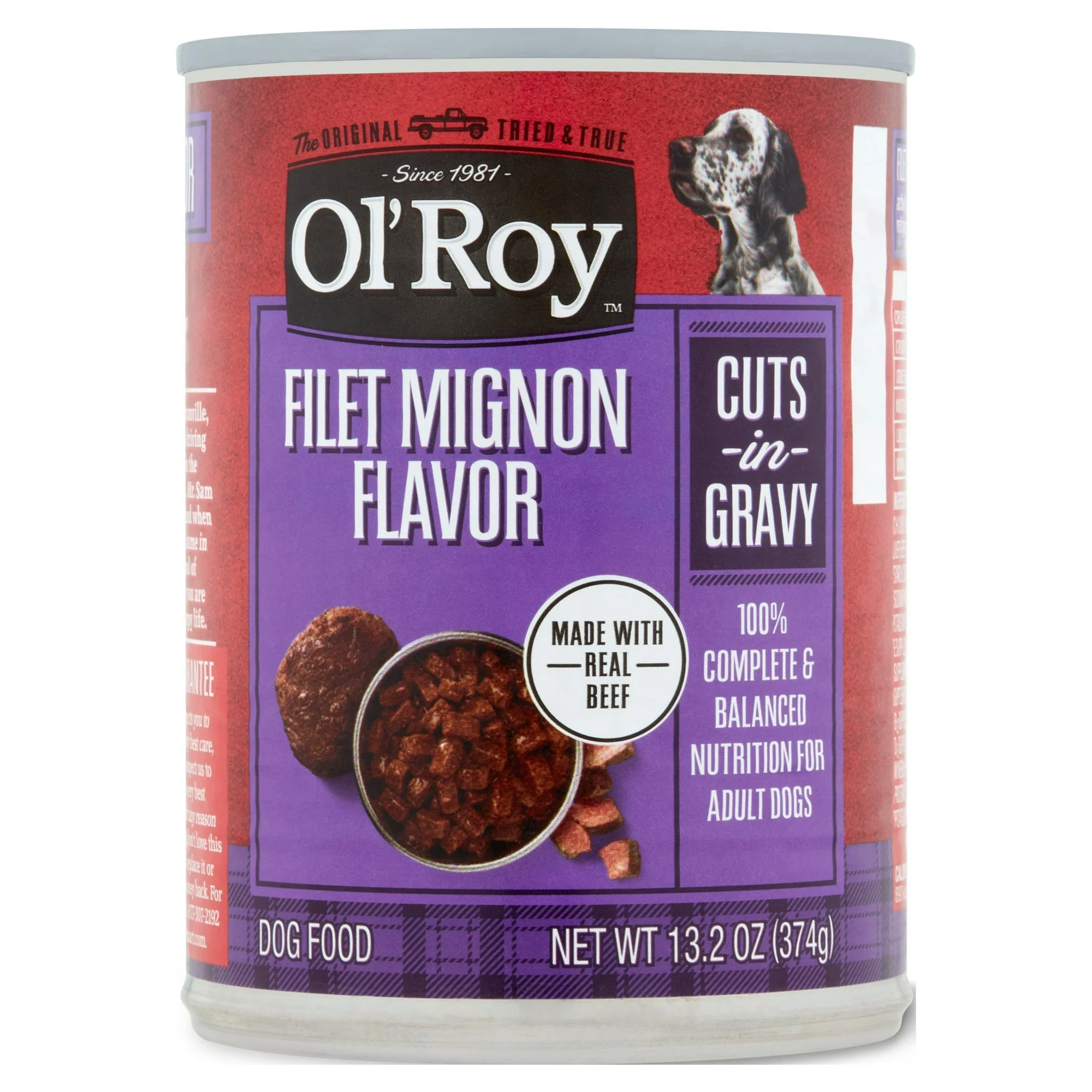
DogFoodAdvisor is reader supported See how
All reviews are 100% impartial but if you buy using links on this page, we may earn a referral fee.
Our Verdict
Ol’ Roy Canned product range is made up of 11 recipes with ratings varying from 2 to 3 stars. The average rating of the whole range is 2 stars.
The table below shows each recipe in this range including our rating and the AAFCO nutrient profile: Growth (puppy), Maintenance (adult), All Life Stages, Supplemental or Unspecified.
| Product line | Rating | AAFCO |
|---|---|---|
| Ol' Roy Savory Loaf with Beef Meaty Loaf | 2 | M |
| Ol' Roy Bacon Cheeseburger Flavor Cuts in Gravy | 2 | M |
| Ol' Roy Chicken and Rice Dinner Meaty Loaf | 3 | M |
| Ol' Roy Savory Cuts with Beef Cuts in Gravy | 2 | M |
| Ol' Roy Filet Mignon Flavor Cuts in Gravy | 2 | M |
| Ol’ Roy Strips in Gravy New York Strip Flavor | 2 | U |
| Ol’ Roy Meaty Loaf Puppy Chicken and Beef Flavor | 2 | U |
| Ol' Roy Country Stew Cuts in Gravy | 2 | M |
| Ol’ Roy Cuts in Gravy Savory Chicken Dinner | 2 | U |
| Ol’ Roy Cuts in Gravy Country Stew | 2 | U |
| Ol' Roy Meaty Loaf Top Sirloin Flavor | 2 | U |
Recipe and Label Analysis
Ol’ Roy Strips in Gravy Filet Mignon Flavor was selected to represent the other products in the line for this review.
Ol' Roy Strips in Gravy Filet Mignon Flavor
Estimated Dry Matter Nutrient Content
Protein
Fat
CarbsCarbohydrates
Water, chicken, meat by-products, wheat flour, beef, liver, modified corn starch, chicken meal, salt, vegetable oil (preserved with BHA/BHT), sodium tripolyphosphate, potassium chloride, calcium carbonate, artificial filet mignon flavor, titanium dioxide (color), iron oxide (color), vitamins (vitamin E supplement, vitamin A supplement, thiamine mononitrate, niacin supplement, d-calcium pantothenate, riboflavin supplement, pyridoxine hydrochloride, vitamin D3 supplement, folic acid, biotin, vitamin B12 supplement), caramel color, minerals (ferrous sulfate, zinc oxide, manganous oxide, copper sulfate, calcium iodate, sodium selenite), choline chloride, onion extract, garlic extract,
Fiber (estimated dry matter content) = 1%
Red denotes any controversial items
| Estimated Nutrient Content | |||
|---|---|---|---|
| Method | Protein | Fat | Carbs |
| Guaranteed Analysis | 8% | 3% | NA |
| Dry Matter Basis | 44% | 17% | 31% |
| Calorie Weighted Basis | 38% | 35% | 27% |
Ingredients Analysis
The first ingredient in this dog food is water, which adds nothing but moisture to this food. Water is a routine finding in most canned dog foods.
The second ingredient is chicken. Chicken is considered “the clean combination of flesh and skin… derived from the parts or whole carcasses of chicken”.1
Chicken is naturally rich in the ten essential amino acids required by a dog to sustain life.
The third ingredient includes meat by-products, an item made from slaughterhouse waste. This is what’s left of slaughtered animals after all the prime striated muscle cuts have been removed.
With the exception of hair, horns, teeth and hooves, this item can include almost any other part of the animal.2
What’s worse, this particular item is anonymous. So, the meat itself can come from any combination of cattle, pigs, sheep or goats — which can make identifying specific food allergies impossible.
Although most meat by-products can be nutritious, we do not consider such vaguely described (generic) ingredients to be as high in quality as those derived from a named animal source.
The fourth ingredient is wheat flour, a highly-refined product of wheat milling. Like corn, wheat is an inexpensive and controversial cereal grain of only modest nutritional value to a dog.
For this reason, we do not consider wheat a preferred component in any dog food.
The fifth ingredient is beef. Beef is defined as “the clean flesh derived from slaughtered cattle” and includes skeletal muscle or the muscle tissues of the tongue, diaphragm, heart or esophagus.3
Beef is naturally rich in all ten essential amino acids required by a dog to sustain life.
The sixth ingredient is liver. Normally, liver can be considered a quality component. However, in this case, the source of the liver is not identified. For this reason, it’s impossible to judge the quality of this item.
The seventh ingredient is corn starch, a starchy powder extracted from the endosperm found at the heart of a kernel of corn. Corn starch is most likely used here to thicken the broth into a gravy.
Corn starch isn’t a true red flag item. Yet we’ve highlighted here for those wishing to avoid corn-based ingredients.
The eighth ingredient is chicken meal. Chicken meal is considered a meat concentrate and contains nearly 300% more protein than fresh chicken.
The ninth ingredient is salt (also known as sodium chloride). Salt is a common additive in many dog foods. That’s because sodium is a necessary mineral for all animals — including humans.
However, since the actual amount of salt added to this recipe isn’t disclosed on the list of ingredients, it’s impossible to judge the nutritional value of this item.
From here, the list goes on to include a number of other items.
But to be realistic, ingredients located this far down the list (other than nutritional supplements) are not likely to affect the overall rating of this product.
With five notable exceptions…
First, vegetable oil is a generic oil of unknown origin. The ratio of omega-6 to omega-3 fats in any oil is nutritionally critical and can vary significantly (depending on the source).
Without knowing more, it’s impossible to judge the quality of an item so vaguely described. However, compared to a named animal fat, a generic vegetable oil cannot be considered a quality ingredient.
What’s worse, this fat is preserved with BHA/BHT, both suspected cancer-causing agents.
Next, we’re always disappointed to find artificial coloring in any pet food. That’s because coloring is used to make the product more appealing to humans — not your dog. After all, do you really think your dog cares what color his food is?
Titanium dioxide is a white coloring agent. Although most claim the pigment to be a safe food additive, one international agency4 has classified titanium dioxide as a “Group 2B carcinogen” possibly linked to cancer in humans.
And iron oxide is a synthetic color additive used in industry to impart a reddish color to food — and paint. In its natural form, this chemical compound is more commonly known as “iron rust”.
In addition, we also note the use of caramel, a natural coloring agent made by caramelizing carbohydrates. It’s used by pet food manufacturers to impart a golden brown tint to the finished product.
However, the concentrated version of this ingredient commonly known as caramel coloring has been more recently considered controversial and found to cause cancer in laboratory animals.5
Next, onion and garlic are controversial items. In rare cases, both have been linked to Heinz body anemia in dogs6.
Although many favor garlic for its claimed health benefits, one must weigh the potential benefits of feeding garlic against its proven tendency to cause subclinical damage to the red blood cells of the animal.
And lastly, the minerals listed here do not appear to be chelated. And that can make them more difficult to absorb. Non-chelated minerals are usually associated with lower quality dog foods.
Nutrient Analysis
Judging by its ingredients alone, Ol’ Roy looks like a below-average wet product.
But ingredient quality by itself cannot tell the whole story. We still need to estimate the product’s meat content before determining a final rating.
The dashboard displays a dry matter protein reading of 44%, a fat level of 17% and estimated carbohydrates of about 31%.
As a group, the brand features an average protein content of 43% and a mean fat level of 19%. Together, these figures suggest a carbohydrate content of 30% for the overall product line.
And a fat-to-protein ratio of about 43%.
Above-average protein. Below-average fat. And above-average carbs when compared to a typical canned dog food.
Even when you consider the protein-boosting effect of the soy flour and textured vegetable protein contained in some recipes in this product line, this looks like the profile of a wet food containing a notable amount of meat.
Ol' Roy Dog Food Recall History
The following automated list (if present) includes all dog food recalls related to Ol' Roy through April 2025.
You can view a complete list of all dog food recalls since 2009 here.
Our Rating of Ol' Roy Dog Food
Ol’ Roy is a grain-inclusive canned dog food using a notable amount of named and unnamed meat by-products as its dominant sources of animal protein, thus earning the brand 1.5 stars.
Compare Ol' Roy Dog Food
How does Ol' Roy compare with The Dog Food Advisor's most recommended brands?
Sources
A Final Word
The Dog Food Advisor does not accept money, gifts, samples or other incentives in exchange for special consideration in preparing our reviews.
However, we do receive a referral fee from online retailers (like Chewy or Amazon) and from sellers of perishable pet food when readers click over to their websites from ours. This helps cover the cost of operation of our free blog. Thanks for your support.
For more information, please visit our Disclaimer and Disclosure page.








